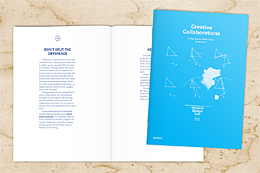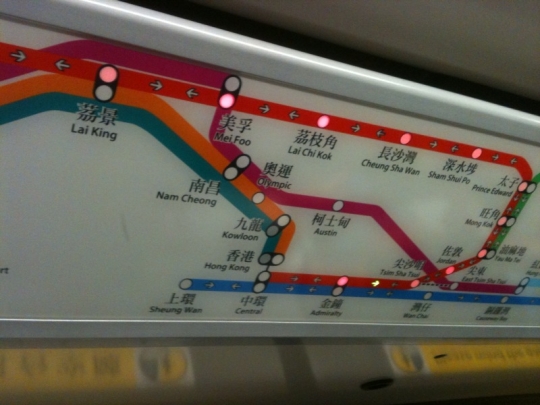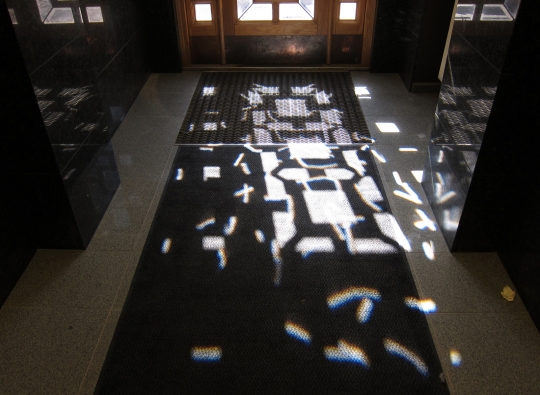Helsinki Design Lab helps government leaders see the "architecture of problems." We assist decision-makers to view challenges from a big-picture perspective, and provide guidance toward more complete solutions that consider all aspects of a problem. Our mission is to advance this way of working—we call it strategic design.
Back in the office after 4 days in Hong Kong and Shanghai where I reconnected with many of the local developments with an eye towards its impact on our work at Sitra. By now everyone is quite familiar with the Chinese scale of development but what really caught my eye was how they're doing it, and the numbers behind it. In Shanghai I discussed the sustainability challenge with Prof. Wu, Vice President of Tongji University, comparing the US and the Chinese context and model.
Here's an interesting fact that Prof. Wu was quick to point out: China has 1/6th the developable land the US has, but 4 times the population. This is a factor of 24, meaning that China has to be 24 times more efficient just to meet the US (which is far from the golden standard in sustainability!). So the question in China is not about copying, but rather of redesigning the model, something that is at the heart of what we do.
The other discussion thread that sparked my interest was the fact that the Chinese were quick to distinguish that their politicians are “selected rather than elected”. This is an interesting distinction, making the public sector more akin to business than the European model.
The CEO—so to speak—is selected by the Board of Directors rather than elected by its employees. And in this sense the public sector is more businesslike in its willingness to experiment and R&D solutions. Clearly there are both upsides and downsides to the two political models, but what makes the Chinese context interesting is the coupling of a grand redesign challenge with a system that is more attuned to risk-taking.
In Finland we have a public sector which is highly developed, but our challenge today lies in our ability to move into uncharted territory, rather than improve the existing. How else will our aging society be able to meet growing service needs with a diminishing tax base? How will we meet our sustainability challenge within an energy and resource dependent economy? These are not efficiency challenges, but rather redesign challenges.
And like China, we will have to clarify our attitude towards risk. Doing new things has an associated risk, but doing nothing is arguably much riskier. So what is Finland’s new relationship to risk?
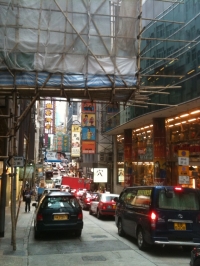
On the busy streets of Hong Kong
In Shanghai I met up with local practitioners too, to complement the “top down” discussion with a grassroots picture from the ground. One of the highlights was to reconnect with Bill Yen, who is doing great at his RMT practice. The practice field is charged with a passion to do, achieve, and redefine… something which is quickly becoming a rarity in our corner of the world.
While elusive at times, “passion” is something at the core of the European innovation challenge. In this sense while I have my own issues with the recent elections in Finland, it has helped inject a moderate measure of passion into our society. Let’s see if we can maintain an upwardly trend on this.
In Hong Kong, I visited the offices of OMA and was generously hosted by David and Betty. We discussed the changing nature of their practice and a continuing shift from designing buildings to redesigning opportunities. Of particular interest is their recent work with the local metro authority, which involves rethinking the idea of efficiency (how could you otherwise improve one of the world’s most efficient subway systems? A task they were asked to do).
My last anecdotes come for the Design in Education conference that I attended while in Hong Kong. Thank you Lorraine Justice and Ken Friedman for leading on this critical issue! While stimulating overall, my take-away from the event was that there is a very, very broad spread on the definition of design and design research within the academe. It made me wonder if one can even draw a boundary on the design community.
But perhaps the leading question conveniently boiled down to yet another number: it costs society on average $500,000 to educate a PhD in Design. How do we define the return-on-investment discussion on that investment?
With the sun glinting off the Baltic and a cloudless sky stretching to the horizon, this weeknote commemorates the beginning of summer in Helsinki. Amazing.
As much as the weather may entice us to spend the afternoons biking around town in search of the perfect corner of park, we've been busy... as we usually are just before summer.
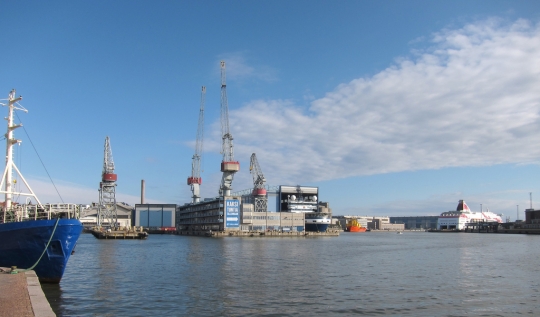
Busy day in the harbor between Hernesaari and Jätkäsaari.
Chrtistian Bason and his team from MindLab stopped by for a visit and a chat about the realities of practicing design within public sector organizations. We've been inspired by MindLab's excellent work in service design for the Ministries of Economic and Business Affairs, Taxation and Employment in Denmark. They're one of the true success stories of public sector design and as we continue our work in Finland we are looking at how to learn from MindLab while folding strategic and systemic opportunities into the mix.
We've also been reviewing and de-briefing after a very busy week with the three concurrent studios that Dan mentioned in his last post. As always, the studios were a great learning experience for us too—as the participants push and pull the boundaries of the studio 'model' we learn where the critical points are.
Riku Siivonen, a journalist who has been working with Sitra on the Synergize Finland programme, prepared a video of the week embedded below. It's in Finnish, but even if you can't understand the words you can get the gist of how things went.
At about 5:25 into the video you will find the beginning of day 5, which is the 'final review' of the studio work. One thing is conspicuously absent as the studio teams present their work: any kind of digital screen or projection.
As we sparred with the teams throughout the week we pushed them to visualize their ideas with the tools at hand. Especially as we all began to think about the final presentation from a goal oriented point of view: the idea is to conclude the studio with a conversation about the systemic understanding of the problem and a collection of action areas that the studio teams have identified as important opportunities.
It's difficult to have a strong conversation about a system when it's presented in a linear presentation (such as Powerpoint slides). What often happens is that the last thing on the screen gets a disproportionate amount of focus or there's an awkward shuffle back and forth through the slides as conversation moves from topic to topic in a nonlinear fashion. For this reason we pushed each of the teams to think about the strategic objective of the conversation and to use the walls around them—aided by giant prints—to create an environment for rich conversation that would help foster and develop their ideas.
Having the contents of the presentation on the wall enables the invited guests and the entire audience to walk themselves back through the whole collection of ideas and important points in their own order and at their own pace. Ultimately this helps the final review be more of a conversation and less of a presentation followed by response.
With encouragement (and a tiny bit of arm-twisting) each of the three teams to relied on the strength of their presentations and their public speaking skills to begin the conversation without the aid of a digital screen. This worked great and no one seemed to complain that they were without the PPT-prosthesis!
All in all it was a great week.
If I had a time machine and I could change one thing I would hop back to the beginning of last week and remove all of the post-it notes from the studio space (you'll see tons in the video). The reason for this is simple: post-it notes trick people into being lazy.
Let me explain. The way that post-it notes are commonly used in workshop settings is to capture an idea on a portable piece of paper. This paper can then be moved around at will and eventually accumulated on a bigger piece of paper and then rolled up and put into the closet and kept forever. Ideas captured. Success?
Post-it notes record ideas and allow them to be easily migrated and reorganized, but it's not a good medium for mutating and synthesizing ideas.
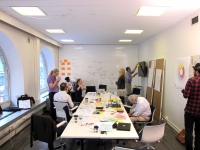
Evidence that we're not allergic to posti-it notes, just that we like their use to be a deliberate choice and not a coincidence of least resistance. This is from the HDL Ageing Studio last summer.
One of the reasons that we prefer large sheets of paper or whiteboards is that they encourage collaborative mutation. If you realize that something is drawn in the wrong place, it must be erased and re-drawn or somehow altered to meet the new intent. By drawing and redrawing, writing and rewriting, opportunities to adjust the content and format—to literally re-present the ideas—continually emerge.
When shuffling post-it notes these opportunites are lost.
Choices about how thoughts are committed to paper and in what format are the visual equivalent of tone of voice. Think about the dramatic differences in interpretation between a statement vocalized in an earnest tone of voice or a sacrastic one. The differences in perception are huge!
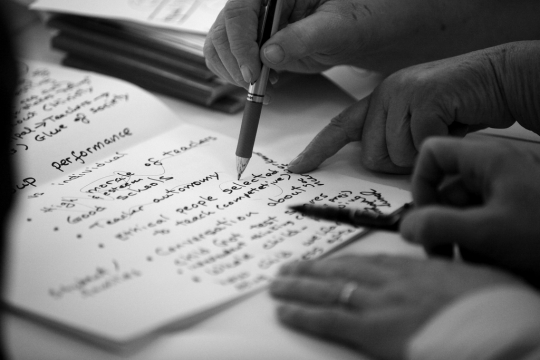
Collaborative writing session during the HDL Studio on Education (2010). Photo: Ivo Corda
By literally re-writing a statement one is able to revisit the choice of wording, its relationship to other content on the board, the scale, the color, and many other factors of the format which will inflect how it is perceived both by the author and by others... In effect, to change the tone of voice.
Even when sketching something quickly we obsess over the small details of how an idea is comitted to paper because it's in this process that a new level of richness emerges.
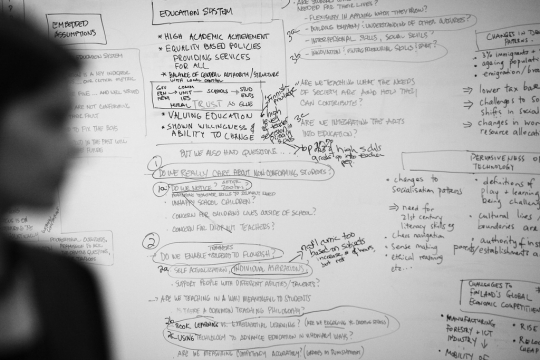
Scene from the HDL Studio on Education (2010). Photo: Ivo Corda
If a person holding a hammer is tempted to see all problems as a nail, what does it say about situations where the answer to everything seems to be a flimsy, sticky-backed square of paper? When doing new work it's sometimes important to test out new tools as well. Next time we'll hide the Powerpoint and post-it notes.
Nevertheless, congratulations to the Synergize Finland studio teams on a job well done (even with some post-its)!

Marco kicks off the Synergize Finland studios with an introduction to strategic design
As Bryan surreptitiously hinted at last week, I’ve just joined the Strategic Design Unit here at Sitra. I’ve relocated to sunny Helsinki from wintry Sydney, which was not an idle decision, though the unique charms of Finland, Sitra and strategic design work ultimately made it easy, almost obvious.
I’ve been working on ‘the other side’ of Helsinki Design Lab (I was a participant in the Sustainability studio, as well as the moderator of the corresponding session at HDL Global, both last year) as well as being a designer on the Arup team for the Low2No project, working closely with Experientia on service design and urban informatics. Equally, I’ve been practicing something akin to the Sitra understanding of strategic design for a while, dating back to my work at the BBC and on through various urban development and building projects at Arup, but I’m very keen to consolidate, develop and articulate this work. To me, Helsinki Design Lab provides the best possible platform for that.
In this respect, my first week proved fascinating, as we’re deploying the strategic design ‘studio’ model within the Synergize Finland programme. Three concurrent studios run all week at Hub Helsinki, addressing matters such as education, youth, entrepreneurship and the future of work, and often the interdependencies between all four.
My colleagues and I are not 'front of house' – three other local designers are in that role – but we help shape the way the event unfolds over the week in numerous small ways, from the ongoing design and calibration of the space, to participating in discussions (that three of us are recent-ish immigrants proves somewhat useful), to advising on visualization aspects throughout.
Throughout, Marco, Bryan, Justin and I are observing and discussing how the strategic design model is performing, noting the differences between these studios and last year’s set, looking especially for the particular differences that design can make in this context. It’s safe to say that this will be an ongoing discussion, which we'll do our best to report on here and elsewhere.
In other news, I’ve been preparing for an Australian state visit (that's a visit by representatives of an Australian state) in a couple of weeks, who wish to learn more about Low2No in Jätkäsaari. So I’m rapidly catching up on the aspects of the project I couldn’t see from my vantage point at Arup – it’s interesting shifting from designer-as-consultant to designer-as-client (or one of the clients, at least.)
The rest of the time has been spent meeting new colleagues at Sitra. It's a unique organisation, and at first glance is staffed by equally unique specialists, experts and high-achievers of all hues. I hugely enjoy the process of immersion in a new context, a new culture and a new organization. These times are precious, when a new country or context is full of intrigue, history and mystery, tiny details leaping out at you from all corners as you begin the process of recasting ‘foreign’ to become ‘home’. And yet this sponge-like state is, or should be, also part of what it means to be a designer (amongst other trades, of course). I often recall the acerbic words of fictional design educator Winter Sorbeck in Chip Kidd’s novel The Cheese Monkeys:
"You are a designer. You have to eat the world with your eyes. You must look at everything as it you're going to die in the next five minutes, because in the relative scheme of things, you are. You can't miss a trick ..."
I've been blogging for over a decade, but I'm coming late to this weeknotes thing, I know. We'll see how this goes. Now, to week 113 and beyond ...
Things reached a state of near-froth on Friday as everyone was zipping around taking care of last minute items for next week's three concurrent studios. Actually no, let me revise that statement after glancing at the clock: this week's three concurrent studios.
We will be located at the Hub Helsinki space all week. It's a wide open floor with plenty of room for three separate teams of 8-9 people. Or so we hope! Last week was the official opening of the Hub so we're helping them beta test the space.

An art installation above Yrjönkatu
Otherwise things are huming along in the way that they do just before summer. Helsinki is finally starting to show signs of warmth and the snow is banished, with the exception of a few piles that are still lingering in shadowy corners.
Visits this week from WeVolve, who are helping us to produce a small 'field guide' for the studios to use next this week, and Sunkyung Han of the Hope Institute, who we had the pleasure to meet a couple years ago in Seoul. Meanwhile, as Justin and Marco have been hammering away on Low2No, I dropped by the Aalto University Department of Architecture for an end of semester critique with Tuomas Toivonen's students. There was some good thinking about how to design intergenerational spaces as well as Low2No-inspired ideas of transitional design.
We ended #111 with an all-hands meeting of Sitra's Strategic Design Unit, except this one was special because we have a new pair of hands! We'll close this weekntoe with a bit of suspense but you'll find out soon enough: #112 will be written by the newest member of our team.
This week was as pleasant as 110 is round. Progress on many fronts and no emergencies, though we do have a glimpse of a storm that might be rumbling our way.
Two weeks from today we will be wrapping up a round of three concurrent studios. With next week as the home stretch, we've been busy working with the Synergize Finland team to nail down all the details. This includes orchestrating field visits to various organizations as part of the Tuesday schedule, inviting guests for our 'final review' on Friday, as well as coaching the design leads and generally preparing everyone for what is likely to be a very busy week.
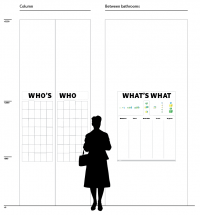
Drafting the infopanel for the studio. The calendar will be laminated so we can mark it up with a dry erase pen as things change on a daily basis.
This week we're also collecing all of the basics, such as schedule of the week and headshots of everyone who will be in the studio at various times, and making sure they get formatted and printed out as giant posters that will be located near the entrance to the studio. That's right, a poster is one of the tricks of the trade. But it's an important poster!
One of the things we learned from the three studios we ran last year (as well as one in Umeå this January) is that it's important to reduce cognitive overhead as much as possible for our participants. This includes making sure people have easy access the information that they need while they're with us for the week. Basically anything we can do to reduce anxiety is key, because that means peoples' minds are free to concentrate on the task at hand.

VOLUME #27:Ageing. Get your copy here.
We also got a nice surprise in the mail. VOLUME magazine sent us a couple copies of issue 27 which focuses on the theme of Ageing and features an essay by myself with contributions from Justin and Marco. The essay recaps the HDL Studioon ageing and delves into the potential of using the studio as a modelfor tackling similar issues in other contexts.
Although we've had opportunities to blab in interviews, we do not often have the chance to reflect on our own work in written form, so this was a (occasionally frustrating) treat. Thanks, VOLUME!
The issue is highly recommended and includes essays from Indy Johar, who was part of our studio, as well as Martti Kalliala who will be leading one of the studios in May and is also the person behind the New Architect's Atlas.
This was a week of incremental updates. Each of our ongoing projects moved forward in silence, so there's little visible progress that we can share in a meaningful way. When writing weeknotes these are frustrating weeks, but in reality they're important for pace-keeping.
A sizable chunk of Week 109 was spent preparing for, hosting, and processing meetings with various teams within Sitra. A week of meetings sounds like it might be dull, but we're starting to build a nice rhythym out of it. It's important work as we continue expanding the surface area between the Strategic Design Unit and the rest of Sitra. Most of these meetings revolve around refining the big picture ideas into an actionable plan, which includes stuff like spending the time to talk through seemingly obvious terms so that everyone in the room is on the same page. Sometimes we also invent and play games.
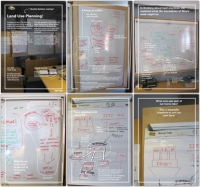
This is what our meeting notes look like. Sorry they're small, but they contain national secrets. (Not really).
Personally, my favorite part is wrapping up a session into a document that captures the essence of the ideas. We've been using something that we colloquially refer to as the augmented reality whiteboard. What this actually means is that we take pictures of the whiteboard and then draw in some lines and words on top of them in InDesign so that the bits which are in chicken scratch come through more clearly. It gets to be a nice challenge to see how much can be left to the marks on the whiteboard and how much needs to be added on top.
In other documentation news, Cynthia from the Young Foundation sends more pictures from the Global Innovation Academy in Bilbao that we talked about last time.
Aalto University School of Art and Design professor Tarja Nieminen visited with some of her graphic design students to talk about strategic design. They were especially interested to hear what its like to work at Sitra and within the government more broadly, and I was keen to hear how they think about their role as graphic designers in the context of upstream issues (like usability/legibility). We also geeked out on the way that type design has to contend with variable ink flow on different newprint paper stocks.
Somewhere in between meetings and visits, Marco revealed a shocking statistic: currently his mailbox includes 22,924 unread emails. He would like you to know that he's not proud of this fact (and most of them are from mailing lists).
Some vignettes from these two blurry weeks.
—
It's monday and Carl Mossfeldt of the Tallberg Foundation stops by for a chat at Sitra. Our two organizations have a region and a culture in common, not to mention a lot of overlap in our respective missions, so how can we work together? It starts—like many things—with a long lunch.
By coincidence, later that day Marco travels to Stockholm to share Sitra's work on strategic design with Members of the Swedish Parliament and the design community at an event organized by SVID.
—
Marco and I are in a conference room with Sitra's Energy and Landmarks programmes, spending a couple hours on a session to assess our combined activities that touch on land use issues in Finland. We're doing more and more of this lately. It doesn't feel like facilitation, but I suppose you could call it that. It feels more like being a portfolio manager of ideas. That was Wednesday.
—
Next day same thing, but this time with Sitra's Synergize Finland programme who we are assisting by organizing three studios next month. With about four weeks till the kick off there is a constant buzz of activity. We're revisiting the details that have been confimed for months to make sure they're still supporting the way the plans have evolved. "How much freedom do we have to adjust the space, did you say? Can we put a curtain here to add acoustic isolation?"
This is our first time opening up the operating model of the studio to people outside of our own small team, so it's a good learning experience. The most painful "whys" are the best ones and most important ones to answer—to make explicit. There are alot of "whys," especially around the role of the softer details.
—
Another Monday: I'm standing in front of 30 people in Bilbao explaining Sitra's use of strategic design as a way to match vision, which can be powerfully vague, with intent, which requires more focus and specificity so that it may guide action and decision. I was delighted to be presenting as part of the 'faculty' of the Young Foundation's Global Innovation Academy (GIA) inaugural programme. We also had a chance to do a quick iteration of the network mapping method that HDL initiated last year in our 2010 studios.

A snapshot from the event in Bilbao
The academy's goal is an important one. If I have to put it into simple words I would say that their challenge is to make social innovation the norm within the public and 3rd sectors. When that happens it will cease to be the buzz-enabled "social innovation" per se and become, more simply, the new definition of good public service. Best of luck to Andrea, Cynthia, Louise, Rob, and the team. We'll be following along!
—
Tuesday: an SMS arrives heralding a successful decision in the Helsinki City council with regards to bicycle lanes around Töölö bay. This came after a breif chat with Martti T. wherein he took it upon himself to visualize the issue using Sketchup, and in doing so change the nature of the debate. We hope to have Martti contribute a guest post on the decision in the near future. Until then we take it as a positive sign that even simple visualizations can have a transformative affect on decisions.
—
Friday. Finally Friday. It's all hands on deck for Sitra's Strategy team and we're huddled around the 14th floor conference room to learn some tips on design ethnography from Ville and Nuppu of WeVolve. This is one small part of the on-going changes at Sitra. It feels good. It feels like an exciting way to end week 108.
It feels a bit like an air traffic control tower in our corner of Sitra-house these days. Between various physical comings and goings, we've also been in the thick of routing projects to and fro.
A big item for us was getting the first 100% text draft of the HDL Studio publication out the door. It was a bit later than we had hoped, so it's nice to have relief from the pressure of being behind schedule. Now that we're receiving feedback from a couple people who have been enlisted to be critical readers it's starting to feel more real. Soon TwoPoints will be doing layouts and then it's truly off. Throttle up.
Marco has been spending his time between Low2No and exploratory meetings for a new (and yet to be named) project. Early feedback is positive but we're still awaiting clearance for take off.
Meanwhile we've been continuing our in-house collaborations as well. In the past month we have really begun to dig into what the Synergize Finland studios will look like. Stuff like securing the studio leads, nailing down key bits of the schedule, and also taking the time to revisit some of the core principles and renew our shared commitment to them. Boarding completed. Requesting clearance to push back from the gate.
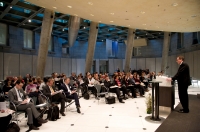
Opening of the SEE conference. Photo by Michael De Lausnay.
On Tuesday I was in Brussels to share Sitra's work with the guests of the SEE Project at their Policy, Innovation, and Design conference. I left the event feeling optimistic that the economic advantages of design+business, the so-called creative economy or ceative industries, is broadly appreciated. Design was also being used in multiple presentations as a way to bring the needs of users back into the center of decision making, particularly in the public sector.
It was nice to see the launch fo the Service Design Toolkit, for instance, because it gives tools to people who might already have the desire to work in a more empathetic way but are struggling to find a structured way to do so.
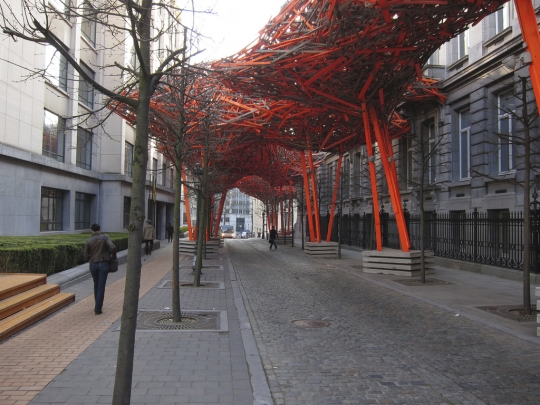
Outside the Flemish Parliament, venue of the SEE Project Final Conference: Policy, Innovation & Design
The mixed content of the event brought to the fore a point which seems unclear at times, particularly when "design" gets introduced to policy contexts. Does "design policy" focus on increasing the demand for design services in a "policy for (to support) design" sort of way? Or, on the other hand, does "design policy" refer to the use of design methods to deliver new or improved services, systems, or strategies?
The latter we think of as "policy by design" and that's squarely where we put our focus at Sitra through initiatives such as HDL. Both 'policy for design' and 'policy by design' have important roles to play, but being specific about which one is on the table at any given moment helps an audience to evaluate the value proposition of design. Thanks to Mark Vanderbeeken of Experientia for putting together a well-rounded lineup that succinctly crystalized these thoughts. Cleared for landing.
I suspect that our week ended the same way that yours did: in utter shock and dismay over the events in Japan. Between the floods in Australia and the ongoing crisis in Japan, the Pacifim Rim has already had a difficult 2011. It has been hard to do anything without checking the news regularly. Half a world away there's little we can do but hope for the best and give what we can.
Before the crisis began, last week was split between writing and sharing.
We continue to draft a document describing the HDL Studios in more depth and detail. This involves a lot of conversations about metaphors, sometimes visual and sometimes not, that can be used to explain abstract concepts like "working with uncertainty." In my brain that equates to the difference between navigating in a forest and navigating on a body of water. In the forest there is a long delay before a trail fades, but a wake disappears as quickly as it is created. Not exactly sure what this means yet.
Marco had a good meeting with the World Design Capital team and a group of representatives from various ministeries to see what's in the works and how public institutions might be involved in WDC2012. We are working on some aspects of this and hope to have some concrete plans to share before summer. Broadly speaking, we want to make it easier for government bodies to use strategic design. Surprise!
Elsewhere, Marco gave a presentation to the Creative Metropoles group about Low2No, using it as an opportunity to look at the new kinds of pressures that today's innovation challenges put on designers and new skills that designers need to develop if they want to be involved in strategic processes.
Coincidentally, friend-of-HDL Paul Nakazawa shared work from RioStudio, a series of architectural design studio that he has been teaching at the Harvard Graduate School of Design, first with Bjarke Ingels and now with Jorge Silvetti and Gabriel Duarte. The studio is exploring the connections between strategic design and architecture by looking at ways in which Rio de Janeiro's build up in advance of the World Cup and Olympics can be focused to create a more lasting, positive impact. This video by one of the students gives a hint at the way they're integrating ideas about phsyical infrastructure with the development strategy:
But yeah, time to check the news again and then get back to writing.
March is a good name for this month. That's what it feels like: a march. Summer is already just around the corner but there's a lot to be done between now and then. These past two weeks have mostly been about sharing.
Sharing with other teams at Sitra, sharing with the world via writing, and sharing with similar organizations who are developing new ways of working on comlex problems.
Marco and I continue to work with the Synergize Finland team as they will be using the Studio model this May. I gave them a brain dump on what a Challenge Briefing is, what role it plays in the studio, and how you structure a similar document. They're off and running on briefings for their studios and it will be cool to see the concept reflected back to us through their experience with it. Marco has been recruiting designers to play the role of studio lead.
During the past two weeks we've also submitted three article for publication on three continents. Two of those discuss the Studio model in greater detail, and the third looks at strategic design vis-a-vis the practice of architecture. We'll post links here when they are available—I believe the first will be the forthcoming issue of Volume Magazine on Ageing.
It feels great to have these deadlines behind us, and I wish I could say that the typing hands can rest now, but no! We soldier on with another big deadline for a draft due in the middle of March. This one is a self-imposed deadline to more thoroughly document the Studio model and our three studios last summer.
On the topic of studios, we caught this interview with John Seely Brown on the radio in Australia (mp3 link):
"In a world of constant change, [design is] the ability to imagine, the ability to take close assessments of where you are versus where you want to be, and figure out how to move from here to there. Design was a nice thing to have in the last few hundred years in a world of stability, but really the form of productive inquiry underlying design is now critical in a world of constant change.
Basically we're living in a world now where our skills have about a 5 year half life. when I started out doing stuff it was a 30 year half-life, so today we have to be at any age able to pick up brand new skills... The studio is one of the most concrete ways of working with the real, working with the concrete, letting the imagination fly, and then collectively with folks around you and mentors actually produce new knowledge."
We were out and about too. I gave a talk to Aalto University's Creative Sustainability course. Marco was in London to participate in the Ecobuild conference and share some of our experiences with Low2No. Afterwards he and I spent a morning catching up up with Nick Mabey at the HQ of E3G. They've just published Degrees of Risk which I haven't had time to read, but knowing Nick and his team it's should be thorough and insightful.
Degrees of Risk is the output of a multi-year process working with climate scientists and security experts to flesh out a framework for moving to a risk management approach to climate change, in contrast to the singular focus on migitiation. Doing so implicates a much wider array of decision-makers, from security to infrastructure, each with established ways to plan for future risk. The framework is an intensely clever way for hacking the climate debate to put it into terms that a larger group of people—everyone—gets: risk.
And now for an abrupt transition: from climate risk to sea ice. Under an unusually bright Sunday sky, I went for a walk on the sea ice last weekend to do a bit of research on Helsinki food culture.
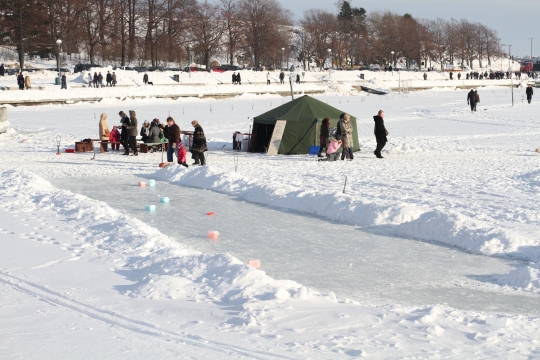
Temporary cafe set up on the ice... and curling sheet!
One of the delightful things about northern cities is the degree to which their geography changes during winter. Helsinki comes alive with recreational opportunities all across the frozen sea. Suddenly the isolated boat gas station becomes a winter cafe, with a new arrival path across the iced-over harbor. Remote coffee shops have new streams of guests who come to roast sausages on outdoor fire pits. Or have a curling match. This won't last for too much longer, given the warm weather we've been having, so I'll have to wait for next year to corral my colleagues into starting the Sitra Curling team.
Week 102 closes with a steady hum—and the clickety clack of more writing.

